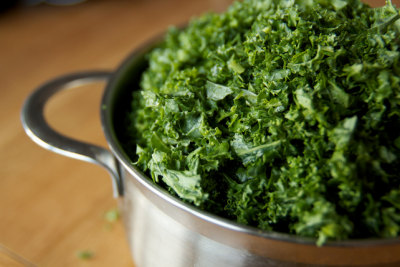 Kale has become synonymous with health, often referred to as a “superfood.” Is kale Paleo? Should it be part of a caveman diet?
Kale has become synonymous with health, often referred to as a “superfood.” Is kale Paleo? Should it be part of a caveman diet?
Nutritional Value of Kale
Serving size: 1 cup, chopped (67 grams)
- Calories: 33
- Total Fat: 0 g
- Saturated fat: 0 g
- Monounsaturated fat: 0 g
- Polyunsaturated fat: 0 g
- Trans fat: 0 g
- Carbohydrate: 7 g
- Protein: 2 g
- Sodium: 29 mg
- Fiber: 1 g
Health Benefits of Kale
Kale is a vegetable, so nutrient-wise, it ranks near the top of the list for beneficial qualities. Kale is packed with a ton of vitamins and minerals including (in one serving) 206% RDA of vitamin A, 684% RDA of vitamin K, and 134% RDA of vitamin C. It also contains significant amounts of B6, manganese, copper, potassium, calcium, iron, and magnesium.
Due to the large amount of nutrients, kale is considered a “superfood” because of how it can positively impact many health conditions. These include improving bone health, lowering blood pressure, and even improving blood glucose in those who have diabetes due to an antioxidant known as alpha-lipoic acid. Kale and other veggies with high amounts of chlorophyll (the pigment that makes kale green) have been shown to be anti-carcinogenic, meaning that kale can help to prevent cancer.
Because kale has a significant amount of fiber, it can help to promote digestive wellness and gut health.
Seasonality of Kale/Where to Buy Kale
Kale is available in most grocery stores year round, but can be found from most farmer’s markets from mid-winter to mid-spring, when it grows at its peak. Kale is not found on the Dirty Dozen list of foods, but isn’t on the Clean Fifteen either, so should be purchased organic when possible.
Kale should be bright green and the leaves should be decently firm or rubbery. Kale should never be slimy or wilted. Warmer temperatures will cause kale to wilt, and wilted kale will have a different taste than truly fresh kale. The larger the size of the kale leaf, the more bitter the taste will be.
Proper storage of kale includes storing in a refrigerator in an air-tight or tightly sealed bag with excess air removed for up to 6 days.
 Should I Eat Kale? Is Kale Paleo?
Should I Eat Kale? Is Kale Paleo?
Only in rare circumstances should kale be avoided. For most, kale is a food that is nutrient dense and the perfect complement to a Paleo diet. It can be steamed, added to soups or stews, mixed into Paleo lasagna dishes, or added to smoothies.
To extract the best nutrients from kale, it should be massaged just after washing. This can be done by gently rubbing the leaves to activate the nutrients. It should then be lightly steamed (approximately 5 minutes) and enjoyed warm, or cooled and added to a smoothie.
